Dogs and Spam: Safety Guide
Feeding dogs Spam isn’t a good idea because it’s loaded with sodium and fat. Just one serving packs 790 milligrams of sodium and 16 grams of fat, which is way too much for your pet and could lead to serious health issues like salt poisoning and pancreatitis. These health problems can cause symptoms including a lot of thirst, vomiting, tiredness, and belly pain, which means you’ll need to see a vet right away.
Spam also has preservatives and sugars that aren’t good for dogs, increasing risks of obesity and diabetes. It’s much better to pick healthier food options for your dog to keep them happy and healthy. Knowing how bad Spam can be for dogs helps you make smarter choices for their diet.
Key Takeaways
- Spam’s sodium causes salt poisoning in dogs.
- Preservatives in Spam risk serious health issues.
- Choose lean meats and veggies over Spam for dogs.
Understanding Spam
Spam, a popular canned meat product, contains pork, ham, salt, water, starch, sugar, and sodium nitrite. This mix offers a specific nutritional value that should be thoughtfully considered before feeding it to dogs. It’s packed with a high amount of sodium, reaching 790 milligrams per serving, and a considerable fat content of about 16 grams. For dogs, these levels are much higher than recommended.
Though Spam does provide 7 grams of protein, along with iron and vitamin B12, the presence of healthier, less processed alternatives makes them a preferable choice for meeting a dog’s dietary needs. The high sodium and fat in Spam pose potential risks to a dog’s health if included regularly in their meals. It’s crucial to prioritize a balanced diet for our canine companions, focusing on foods that support their overall well-being.
Spams Nutritional Profile
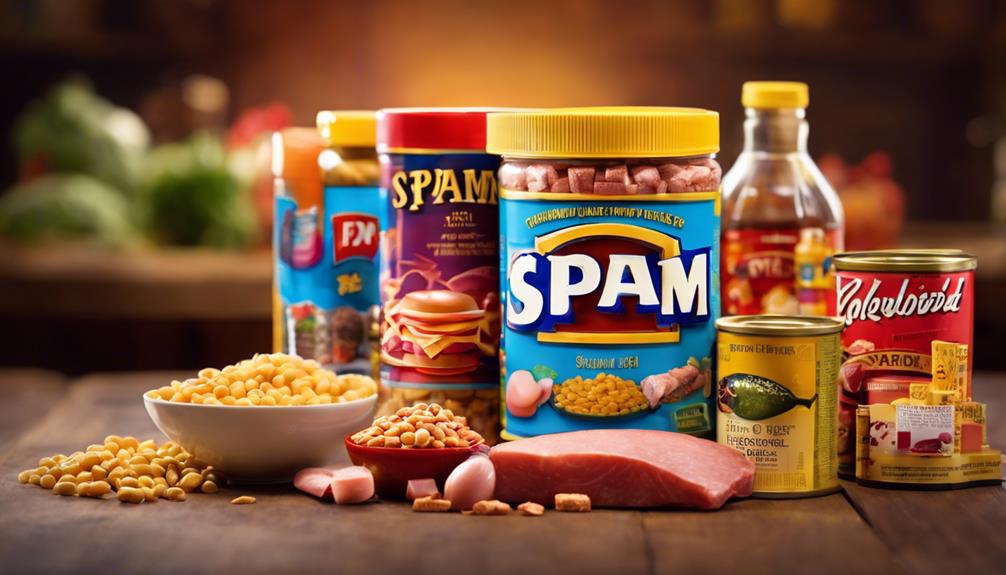
Examining the nutritional content of Spam, it’s clear that each portion packs 180 calories, with a high 16 grams of fat and a significant sodium level reaching up to 790 milligrams. This highlights the product as a processed meat, bringing to light the potential health concerns tied to its high sodium and fat content. Despite offering 7 grams of protein, some iron, and vitamin B12, the drawbacks associated with its fat and sodium levels are significant.
Given its processed nature and high sodium content, Spam might not be the best choice for dogs. Their dietary needs differ greatly from humans, and high sodium foods can be especially harmful to them. This analysis of Spam’s nutritional makeup serves as a reminder to be mindful of our food choices, particularly when it comes to feeding our pets.
Health Risks for Dogs
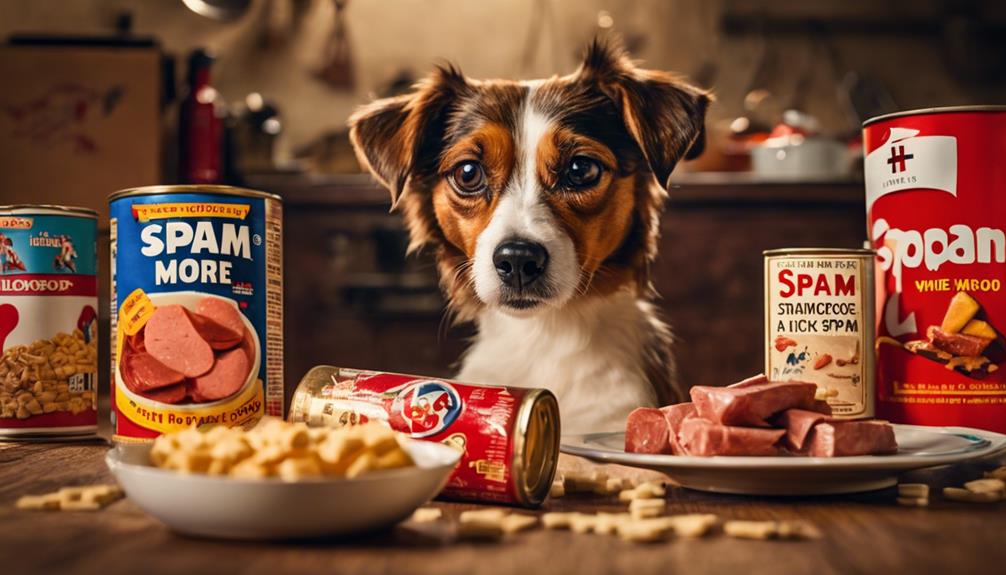
The high sodium content in Spam poses serious health risks to dogs, including the dangers of salt poisoning and pancreatitis. Dogs might also experience allergic reactions, showing symptoms like skin rashes or upset stomachs. This highlights the need for pet owners to consider healthier dietary options for their dogs, avoiding processed meats that carry these risks.
Salt poisoning can lead to serious complications in dogs, while pancreatitis, an inflammation of the pancreas, can be triggered by high-fat foods like Spam. Allergic reactions in dogs might not be as common, but they’re still a risk worth noting. When choosing what to feed your pet, it’s best to look for foods that support their health without exposing them to unnecessary dangers.
High Sodium Content
The high sodium content in Spam is harmful to dogs, leading to salt poisoning and its symptoms. Dogs are especially vulnerable to the effects of too much salt, which can cause dehydration and upset the balance of electrolytes in their bodies. This imbalance might result in serious health issues, such as high blood pressure and kidney problems.
Signs of salt poisoning include upset stomach, lethargy, and excessive thirst. Pet owners should watch for these symptoms and get in touch with a vet quickly if they think their dog has eaten Spam. A timely visit to the vet can help avoid more serious problems and keep your dog healthy.
Pancreatitis Risk Increase
Feeding dogs Spam poses serious health risks beyond just its high sodium levels. One major concern is the risk of pancreatitis, a condition marked by the inflammation of the pancreas. This can lead to symptoms like stomach upset, abdominal pain, and a drop in appetite for our canine friends. If not properly managed, pancreatitis can become a chronic issue, causing ongoing digestive problems and even increasing the likelihood of diabetes in dogs.
To protect dogs from pancreatitis, it’s crucial to monitor their fat intake closely. Veterinarians are key in offering advice on the best diet for each dog, helping to prevent this condition. By adhering to a vet’s dietary guidelines, dog owners can avoid these severe health issues, keeping their pets healthy and happy.
Allergic Reactions Possibility
Feeding your dog Spam might not be a good idea because it can cause allergic reactions due to its ingredients and additives. These reactions can show up as skin rashes, itching, or an upset stomach, which are signs that your dog’s body is not handling something in the Spam well.
It’s important to keep an eye on your pet after they eat Spam. If you notice any of these symptoms, talking to a vet is a smart move. They can help figure out what’s causing the reaction and what steps to take next.
To avoid any problems, it’s best not to give Spam to dogs that already have allergies or sensitivities to its ingredients.
Salt Poisoning Explained
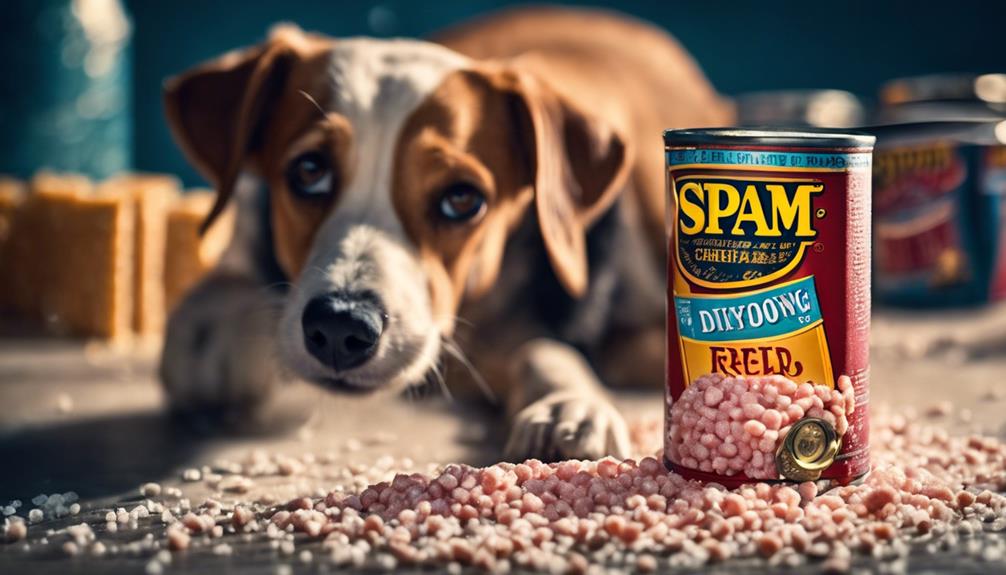
Salt poisoning poses a significant health risk to dogs when they consume foods with too much sodium, like Spam. Such foods contain sodium amounts far beyond what dogs should have. Symptoms of this condition include increased thirst, clumsiness, stomach issues, tiredness, and shaking, which signal the need for urgent care from a vet.
It’s essential to keep an eye on what your dog eats and ensure they always have plenty of fresh water, especially after eating salty foods.
Symptoms of Salt Poisoning
Being aware of the signs of salt poisoning is crucial for dog owners, especially if their dogs have eaten foods with a lot of salt, like spam.
| Symptom | Description | Action |
|---|---|---|
| Excessive Thirst | Dogs might drink more water than they usually do. | Make sure they have plenty of water. |
| Stomach Upset | Symptoms can include throwing up or having diarrhea. | Keep an eye on them and make them comfortable. |
| Loss of Coordination | They may have trouble walking or standing up. | Keep them safe from getting hurt. |
| Tremors | Shaking that can mean neurological problems. | Get them to a vet right away. |
| Tiredness | If they’re unusually sleepy or don’t want to move much. | Watch them and talk to a vet. |
It’s essential to watch for these symptoms and get veterinary help quickly to avoid serious health issues from salt poisoning.
Preventing Salt Overdose
To protect your dog from the dangers of excessive salt, it’s crucial to know how too much sodium can harm their health. Dogs can be especially vulnerable to salt poisoning, which manifests through symptoms like dehydration, loss of coordination, upset stomach, fatigue, and shaking. This happens because too much salt throws off the body’s fluid balance, leading to various health problems.
It’s key to watch out for early signs of salt poisoning, such as an increased need to drink water and clumsy movements.
If your dog starts showing signs like shaking, being unusually tired, or having digestive issues after eating foods high in sodium like spam, you should get veterinary help right away. This quick response can prevent the situation from getting worse and safeguard your dog from the severe effects of a salt overdose.
The Pancreatitis Connection
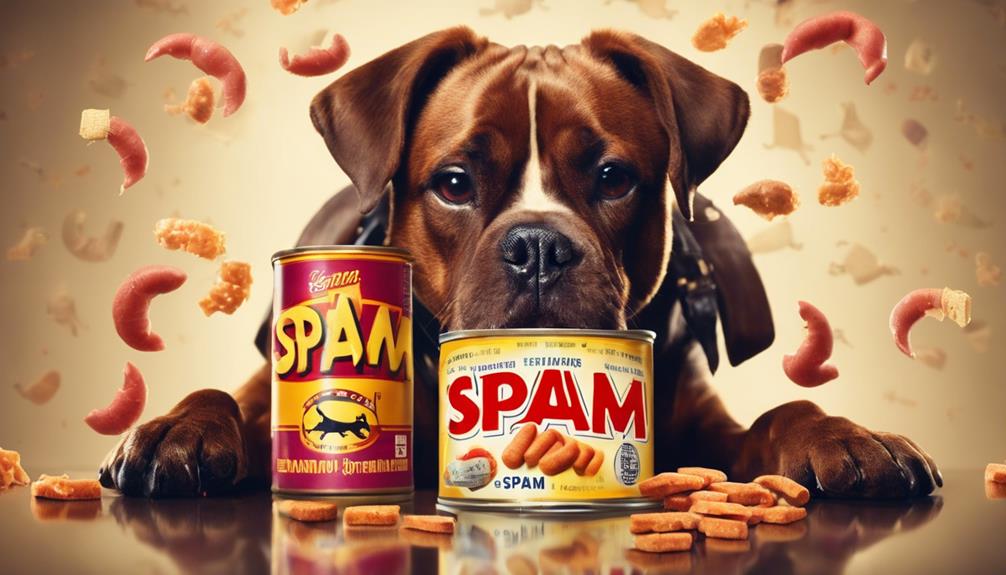
Giving dogs high-fat foods like Spam can significantly increase their chances of getting pancreatitis. This condition causes the pancreas to become inflamed, leading to serious health problems.
Foods rich in fat are the main cause of this disease, causing symptoms like upset stomach, abdominal pain, tiredness, and lack of appetite. When dogs eat a lot of fatty foods over time, they can have ongoing digestive problems and might even develop diabetes.
It’s crucial for dog owners to avoid giving their pets high-fat items to protect their health. Keeping dogs away from foods like Spam helps prevent pancreatitis and its associated health issues. This proactive approach is key to keeping dogs healthy and avoiding serious illnesses.
Preservatives and Sugar Issues
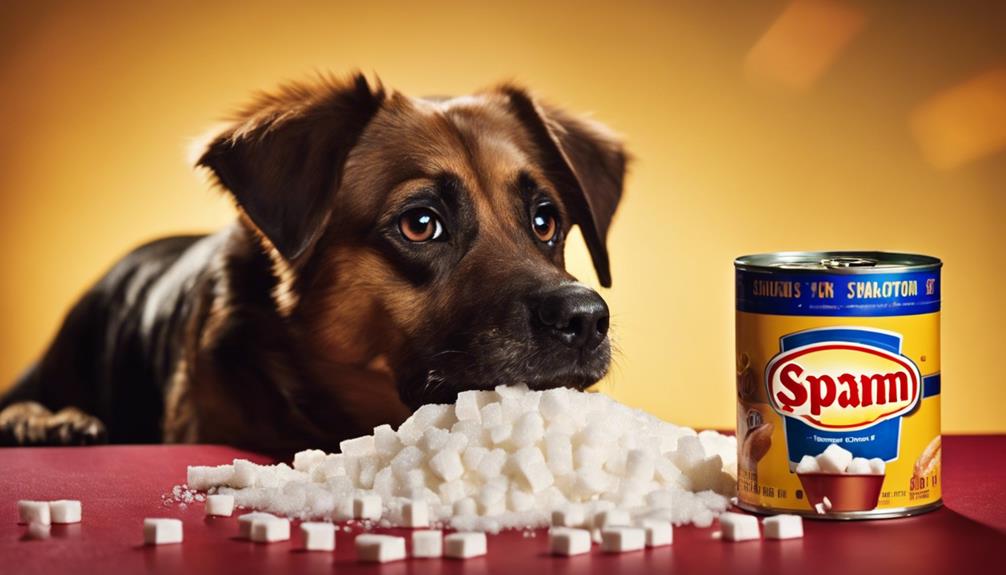
Spam’s high fat content isn’t the only concern for dog owners. This canned meat also contains harmful preservatives and sugars that can cause health issues in dogs, such as weight gain, obesity, diabetes, and dental problems. Sodium nitrite, a preservative in Spam, poses a serious risk and could lead to significant health problems for dogs. Dogs might also have allergic reactions to processed meats, showing symptoms like skin rashes, itching, or stomach upset.
Even though Spam comes in various versions like Lite, Turkey, and Low Sodium, they still carry risks due to their salt content, preservatives, and additives. In contrast, fresh meats such as chicken, turkey, or lean beef are much safer for dogs. These options are better because they contain less salt and no harmful preservatives. It’s crucial for pet owners to prioritize their pets’ health by choosing these healthier food options.
Safer Dietary Alternatives

For dog owners looking for healthier food options, lean meats, omega-3 rich fish, and a selection of fruits and veggies are great choices. Lean meats like chicken, turkey, or beef are lower in fat and sodium, making them a better alternative for your pet. Fish, packed with omega-3 fatty acids, is also a fantastic source of protein that benefits your dog’s health.
Adding safe fruits and vegetables such as carrots, blueberries, and green beans to your dog’s diet can provide them with essential nutrients. Plain yogurt is another good option because it contains probiotics that help with digestion. Preparing homemade meals with ingredients like rice, chicken, and vegetables can ensure your dog gets a balanced diet.
These options not only promote your dog’s overall well-being but also keep them happy and healthy. It’s all about choosing the right ingredients and preparing them in a way that suits your dog’s dietary needs.
Recognizing Symptoms
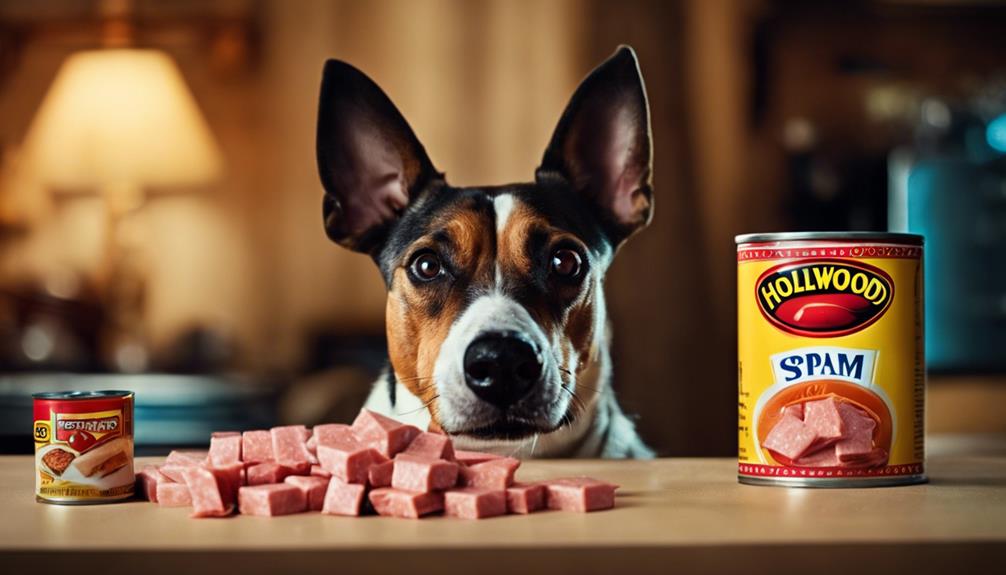
After your dog eats Spam, watch them carefully to catch any bad reactions early. This is key to stopping bigger health problems from developing. Here are some symptoms to look out for:
- Vomiting and Diarrhea: These symptoms often show that your dog’s body is not handling the Spam well, likely due to its high salt and fat levels.
- Excessive Thirst and Lethargy: These could be warning signs of salt poisoning, a serious condition caused by the high sodium content in Spam.
- Loss of Coordination: Along with tremors, this could mean salt poisoning too.
- Allergic Reactions: Symptoms like skin rashes, itching, or an upset stomach can indicate an allergic response.
Seeing any of these signs means you should get in touch with a vet right away. This ensures your dog gets the care they need.
Emergency Response Steps
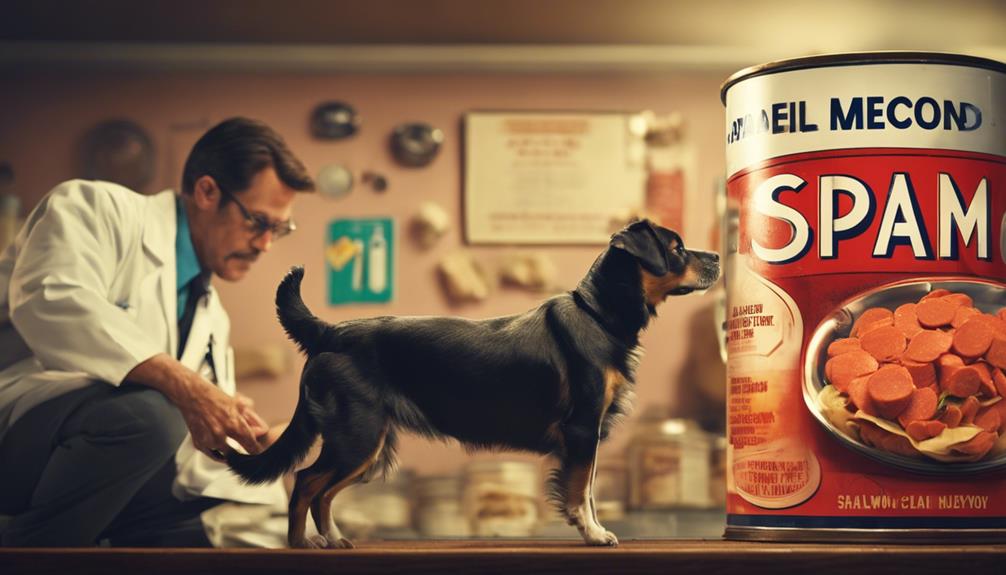
If your dog eats Spam, it’s vital to act quickly. Spam, a type of processed meat, is loaded with sodium and can harm your dog if they eat too much. You need to figure out how much Spam your dog ate and keep an eye out for any negative reactions they might have.
| Step | Action | Reason |
|---|---|---|
| 1. Assess | Find out the quantity of Spam your dog has eaten. | This helps you understand the potential risk. |
| 2. Monitor | Look for signs like vomiting, diarrhea, or an upset stomach. | Catching problems early can make a big difference. |
| 3. Consult | Get advice from a vet, especially if your dog shows any symptoms. | A vet can offer the right guidance to avoid serious health problems. |
Getting veterinary help quickly is crucial to ensure your dog stays safe after eating processed food like Spam.
Frequently Asked Questions
Is Spam Harmful to Dogs?
- Spam’s high salt risks dog obesity.
- Can cause allergic reactions in some dogs.
- May lead to pancreatitis and nutritional gaps.
Is Canned Luncheon Meat Good for Dogs?
- Canned meat is high in sodium, harmful to dogs.
- Contains preservatives; bad for their digestion.
- Choose healthier food options for dogs.
Can Dogs Eat Canned Meat?
- Canned meat can upset dogs’ stomachs; choose carefully.
- Opt for low-salt, fresh meat over canned varieties.
- Organic options reduce allergy and preservative risks.
What Meat Should Dogs Not Eat?
- Dogs should not eat raw chicken; it’s risky.
- Toxic foods for dogs include chocolate and grapes.
- Health hazards: Avoid xylitol, caffeine, and alcohol for pets.

